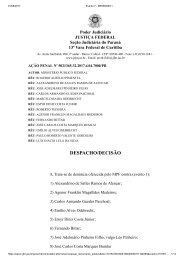Brasil só deve dominar Leitura em 260 anos, aponta estudo do Banco Mundial Relatorio Banco Mundial _Learning
You also want an ePaper? Increase the reach of your titles
YUMPU automatically turns print PDFs into web optimized ePapers that Google loves.
technical challenges. 54 Ex ante linking of measur<strong>em</strong>ents<br />
through common it<strong>em</strong>s is likely to prove much<br />
more technically sound and cost-effective.<br />
* * *<br />
Education syst<strong>em</strong>s are unlikely to tackle the learning<br />
crisis unless it becomes clearly visible. This is possible<br />
only through well-designed measures of learning. To<br />
be effective, “learning metrics” must overcome two<br />
important challenges: ensuring that information<br />
leads to action, and minimizing the potential perverse<br />
impacts of measur<strong>em</strong>ent. Alarm at the rise of<br />
a “testing” culture has <strong>do</strong>minated recent discourse.<br />
But in most low-learning contexts there is too little<br />
assessment and, consequently, too little accountability<br />
for learning in the syst<strong>em</strong>.<br />
Notes<br />
1. Pritchett, Banerji, and Kenny (2013).<br />
2. Muralidharan, Singh, and Ganimian (2016).<br />
3. Eggen and Stobart (2014); Sellar and Lingard (2013).<br />
4. Carnoy and others (2016).<br />
5. Pritchett (2013).<br />
6. OECD (2011).<br />
7. Guimarães de Castro (2012).<br />
8. Breakspear (2012).<br />
9. Kulpoo (1998).<br />
10. Ertl (2006).<br />
11. Greaney and Kellaghan (2008).<br />
12. Dee and Jacob (2011).<br />
13. Booher-Jennings (2005); Cullen and Reback (2006); Figlio<br />
and Getzler (2006); Jacob (2005); Jennings and Beveridge<br />
(2009); Neal and Schanzenbach (2010); Reback (2008).<br />
14. Carnoy and others (2016); Glewwe and others (2017);<br />
OECD (2016); Xu and Dronkers (2016).<br />
15. Székely (2011).<br />
16. Greaney and Kellaghan (2008).<br />
17. Baker and others (2010); Dixon and others (2013).<br />
18. Bellamy and Raab (2005); Meijer (2009).<br />
19. Bruns, Filmer, and Patrinos (2011).<br />
20. Afrobarometer (2015); Uwezo (2014).<br />
21. World Bank (2003).<br />
22. Pritchett, Banerji, and Kenny (2013).<br />
23. R4D (2015).<br />
24. ASER Centre (2016).<br />
25. Lieberman, Posner, and Tsai (2014).<br />
26. Michener and Ritter (2016); Tanaka (2001).<br />
27. Nicolai and others (2014).<br />
28. Ganimian (2015).<br />
29. Fox (2007); Hood (2010); Worthy (2015).<br />
30. Meckes and Carrasco (2006).<br />
31. Benveniste (2002); Peterson and West (2003).<br />
32. Loewenstein, Sunstein, and Golman (2014).<br />
33. Björkman and Svensson (2010).<br />
34. Barr and others (2012); Björkman and Svensson (2010).<br />
35. Barr and others (2012); Lieberman, Posner, and Tsai<br />
(2014).<br />
36. Breakspear (2012).<br />
37. Figazzolo (2009).<br />
38. Tawil and others (2016).<br />
39. UIS (2016).<br />
40. By linking it<strong>em</strong>s across assessments—and including<br />
national assessments—coverage might be increased.<br />
But the fact that several large low- and middle-income<br />
countries still lack measures of learning means that<br />
comparable information r<strong>em</strong>ains missing for many children<br />
and youth outside of high-income countries.<br />
41. Muralidharan and Sundararaman (2011).<br />
42. Jackson (2016).<br />
43. Chetty and others (2010).<br />
44. Durlak and others (2011); Heckman, Pinto, and Savelyev<br />
(2013); Murnane and others (2001).<br />
45. Heckman, Stixrud, and Urzua (2006).<br />
46. Durlak, Weissberg, and Pachan (2010).<br />
47. Carneiro, Crawford, and Goodman (2007).<br />
48. Carneiro, Crawford, and Goodman (2007); Heckman,<br />
Pinto, and Savelyev (2013).<br />
49. Heckman, Stixrud, and Urzua (2006).<br />
50. Cunha and Heckman (2007, 2008); OECD (2015).<br />
51. Sandefur (2016).<br />
52. Neal (2013).<br />
53. Guimarães de Castro (2012).<br />
54. Altinok, Diebolt, and D<strong>em</strong>eul<strong>em</strong>eester (2014); Altinok<br />
and Murseli (2007); Sandefur (2017).<br />
References<br />
Afrobarometer. 2015. “Uganda, Round 6 Data (2015).” D<strong>em</strong>ocracy<br />
in Africa Research Unit, Center for Social Science<br />
Research, University of Cape Town, Rondebosch, South<br />
Africa. http://afrobarometer.org/data/uganda-round-6<br />
-data-2015.<br />
Altinok, Nadir, Claude Diebolt, and Jean-Luc D<strong>em</strong>eul<strong>em</strong>eester.<br />
2014. “A New International Database on Education<br />
Quality: 1965–2010.” Applied Economics 46 (11):<br />
1212–47.<br />
Altinok, Nadir, and Hatidje Murseli. 2007. “International<br />
Database on Human Capital Quality.” Economics Letters<br />
96 (2): 237–44.<br />
ASER Centre. 2016. “Annual Status of Education Report<br />
2016.” New Delhi. http://www.asercentre.org/p/289.html.<br />
Baker, Eva L., Paul E. Barton, Linda Darling-Hammond,<br />
Edward Haertel, Helen F. Ladd, Robert L. Linn, Diane<br />
Ravitch, et al. 2010. “Probl<strong>em</strong>s with the Use of Student<br />
Test Scores to Evaluate Teachers.” EPI Briefing Paper<br />
#278, Economic Policy Institute, Washington, DC.<br />
Barr, Abigail, Frederick Mugisha, Pieter Serneels, and<br />
Andrew Zeitlin. 2012. “Information and Collective Action<br />
in Community-Based Monitoring of Schools: Field and<br />
98 | World Development Report 2018








